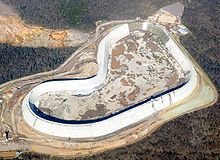
Back Rolbeton Afrikaans خرسانة مضغوطة بالمدحلة Arabic Walzbeton German بتن غلطکی Persian Béton compacté au rouleau French Beton wałowany Polish Beton compactat cu role Romanian Уплотненный катком бетон Russian

Roller-compacted concrete (RCC) or rolled concrete (rollcrete) is a special blend of concrete that has essentially the same ingredients as conventional concrete but in different ratios, and increasingly with partial substitution of fly ash for portland cement.[2] The partial substitution of fly ash for Portland Cement is an important aspect of RCC dam construction because the heat generated by fly ash hydration is significantly less than the heat generated by portland cement hydration. This in turn reduces the thermal loads on the concrete and reduces the potential for thermal cracking to occur. RCC is a mix of cement/fly ash, water, sand, aggregate and common additives, but contains much less water. The produced mix is drier and essentially has no slump. RCC is placed in a manner similar to road paving; the material is delivered by dump trucks or conveyors, spread by small bulldozers or specially modified asphalt pavers, and then compacted by vibratory rollers.
In dam construction, roller-compacted concrete began its initial development with the construction of the Alpe Gera Dam near Sondrio in North Italy between 1961 and 1964. Concrete was laid in a similar form and method but not rolled.[3] RCC had been touted in engineering journals during the 1970s as a revolutionary material suitable for, among other things, dam construction.[4] Initially and generally, RCC was used for backfill, sub-base and concrete pavement construction, but increasingly it has been used to build concrete gravity dams because the low cement content and use of fly ash cause less heat to be generated while curing than do conventional mass concrete placements. Roller-compacted concrete has many time and cost benefits over conventional mass concrete dams; these include higher rates of concrete placement, lower material costs and lower costs associated with post-cooling and formwork.
- ^ "U. S. Society on Dams holds annual meeting and conference in California". HydroWorld.com. PennWell Corporation. 2010-04-16. Retrieved 2010-04-19.
- ^ Roller Compacted concrete (RCC)
- ^ I︠U︡riĭ Borisovich Mgalobelov, Non-conventional Concrete Dams on Rock Foundations: a critical review of patents and licences, Taylor & Francis, 1997, p.111
- ^ Cite error: The named reference
Am Sci, Reliably Safewas invoked but never defined (see the help page).